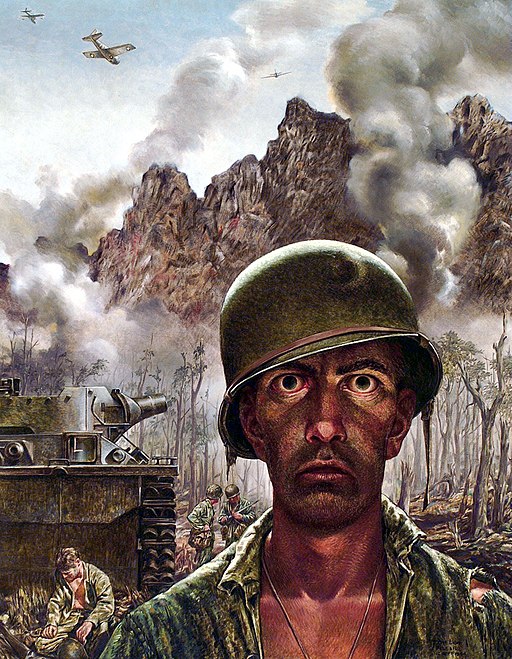
“North Fork of the Platte Nebraska” by Albert Bierstadt reflected the 19th-century American idea of Manifest Destiny. The West represented natural beauty, and the rivers served both obstacles and transportation routes to westward expansion.
The Platte River is a major river in the State of Nebraska. The Platte River is a tributary of the Missouri River, which itself is a tributary of the Mississippi River, which flows to the Gulf of Mexico.
Over most of its length, the Platte is a broad, shallow, meandering stream with a sandy bottom and many islands.
The river valley played an essential role in the westward expansion of the United States, providing the route for several major emigrant trails, including the Oregon, California, Mormon, and Bozeman trails.
The first Europeans to see the Platte were French explorers and fur trappers in 1714. They first called it Nebraska, a transliteration of the Otoe people’s names, meaning “flat water.”
The native Indian “flat water” expression is very close to the French words “rivière plate” (“flat river”), the probable origin of the name Platte River.
Bierstadt’s canvases were popular with railroad and mining magnates, based on his vision of the west, which glorified the western frontier and its promise.
His canvases focused on landscape panoramas with mountain peaks shrouded in dramatic mists, the sun exploding on the horizon into cloudscapes churning with pinks, violets, and gold.
Albert Bierstadt was, during his lifetime, one of America’s most popular and successful artists.
North Platte River
The North Platte River is a major tributary of the Platte River and is approximately 716 miles (1,152 km) long, counting its many curves. It travels through the U.S. states of Colorado, Wyoming, and Nebraska.
The North Platte and South Platte River join to form the Platte River in western Nebraska near the city of North Platte, Nebraska.
Manifest Destiny
Manifest destiny was an American cultural belief of the 19th-century United States that American settlers were destined to expand across North America.
It was a general idea rather than a specific policy made with a motto. Ill-defined but keenly felt, manifest destiny complemented other popular ideas of the era, including America’s potential greatness and Romantic nationalism.
While many saw it as American expansionism, be it into Mexico or across the Pacific, others saw the term as a call to be an example for the world.
The belief in an American mission to promote and defend democracy throughout the world, as expounded by Jefferson and continued by Wilson, and later leaders, continues to influence American political ideology.
“Manifest destiny” is sometimes used by critics of U.S. foreign policy to characterize interventions in the Middle East and elsewhere.
North Fork of the Platte Nebraska
- Title: North Fork of the Platte Nebraska
- Artist: Albert Bierstadt
- Year: 1863
- Medium: Oil on canvas
- Dimensions 18 1/8 × 20 1/8 × 2 1/2 in de(46 × 51.1 × 6.4 cm)
- Movement: Hudson River School
- Category: American Artist
- Museum: Gilcrease Museum, Tulsa
Albert Bierstadt
Albert Bierstadt (1830 – 1902) was a painter of sweeping landscapes of the American West. He joined several journeys of the Westward Expansion to paint the scenes.
Bierstadt was born in Prussia, but his family moved to the United States when he was 1. He returned to Europe to study painting for several years in Düsseldorf.
He became part of the second generation of the Hudson River School in New York, an informal group of like-minded painters who started painting along the Hudson River.
Bierstadt was a critical interpreter of the western landscape, and he is also grouped with the Rocky Mountain School.
Albert Bierstadt
- Artist: Albert Bierstadt
- Born: 1830, Solingen, Rhine Province, Prussia
- Died: 1902 (aged 72), New York City
- Nationality: German-American
- Notable works:
- The Falls of St. Anthony
- Looking Down Yosemite Valley, California
- Alaskan Coastal Range
- The Rocky Mountains, Lander’s Peak
- North Fork of the Platte Nebraska
Albert Bierstadt’s Lavish Landscapes of The American West
A Tour of Washington, D.C. Museums
- National Gallery of Art
- National Museum of American History
- National Air and Space Museum
- National Museum of African American History and Culture
- National Museum of Natural History
- National Portrait Gallery
- Smithsonian American Art Museum
- The Phillips Collection
- Hirshhorn Museum and Sculpture Garden
- International Spy Museum
- National Museum of Women in the Arts
- United States Holocaust Memorial Museum
“Albert Bierstadt: Witness to a Changing West”
A Tour of New York Museums
- Metropolitan Museum of Art – MET
- Museum of Modern Art, NYC
- Intrepid, Sea, Air & Space Museum
- Neue Galerie New York
- The Cloisters
- Solomon R. Guggenheim Museum
- American Museum of Natural History
- Museum of the City of New York
- New-York Historical Society
- Frick Collection
- Met Breuer
- Rubin Museum of Art
- Whitney Museum of American Art
- Brooklyn Museum
American Landscape Painting: Albert Bierstadt and the American Land
~~~
“The best material for the artist is the world.”
– Albert Bierstadt
~~~
Photo Credit: 1) By Wikipedia; Albert Bierstadt / Public domain.
Popular this Week








 Sponsor your Favorite Page
Sponsor your Favorite Page SEARCH Search for: Search Follow UsJoin – The JOM Membership Program
Sponsor a Masterpiece with YOUR NAME CHOICE for $5
Share this:
- Tweet
